Magnetic Equivalent Circuit Modelling of Synchronous Reluctance Motors
Abstract
:1. Introduction
SynRM Fundamental Unit MEC Model
2. MEC Model Development for a 4-Pole 36-Slot SynRM
2.1. The Magnetic Equivalent Circuit Model
2.2. Magnetic Equivalent Circuit Model of the Stator
2.3. Magnetic Equivalent Circuit Model of the Rotor
2.4. SynRM Air-Gap Permeance Model
3. Matrix Formulation of the MEC
Torque Calculation
4. Simulation Results
5. Conclusions
Author Contributions
Funding
Institutional Review Board Statement
Informed Consent Statement
Data Availability Statement
Conflicts of Interest
References
- Mi, C.; Filippa, M.; Liu, W.; Ma, R. Analytical method for predicting the air-gap flux of interior-type permanent-magnet machines. IEEE Trans. Magn. 2004, 40, 50–58. [Google Scholar] [CrossRef]
- Han, S.H.; Jahns, T.M.; Soong, W.L. A Magnetic Circuit Model for an IPM Synchronous Machine Incorporating Moving Airgap and Cross-Coupled Saturation Effects. In Proceedings of the 2007 IEEE International Electric Machines Drives Conference, Antalya, Turkey, 3–5 May 2007; Volume 1, pp. 21–26. [Google Scholar] [CrossRef]
- Lovelace, E.; Jahns, T.; Lang, J. A saturating lumped-parameter model for an interior PM synchronous machine. IEEE Trans. Ind. Appl. 2002, 38, 645–650. [Google Scholar] [CrossRef]
- Rahman, M.; Little, T.; Slemon, G. Analytical models for interior-type permanent magnet synchronous motors. IEEE Trans. Magn. 1985, 21, 1741–1743. [Google Scholar] [CrossRef]
- Ostović, V. Magnetic Equivalent Circuit Presentation of Electric Machines. Electr. Mach. Electromech. 1987, 12, 407–432. [Google Scholar] [CrossRef]
- Slemon, G.R. Equivalent circuits for transformers and machines including nonlinear effects. Proc. IEE 1953, 5, 129–143. [Google Scholar] [CrossRef]
- Sudhoff, S.D.; Kuhn, B.T.; Corzine, K.A.; Branecky, B.T. Magnetic Equivalent Circuit Modeling of Induction Motors. IEEE Trans. Energy Convers. 2007, 22, 259–270. [Google Scholar] [CrossRef]
- Ostovic, V. A Method for Evaluation of Transient and Steady State Performance in Saturated Squirrel Cage Induction Machines. IEEE Trans. Energy Convers. 1986, 3, 190–197. [Google Scholar] [CrossRef]
- Fiennes, J. New approach to general theory of electrical machines using magnetic equivalent circuits. Proc. Inst. Electr. Eng. 1973, 120, 94. [Google Scholar] [CrossRef]
- Rasmussen, C.; Ritchie, E. A magnetic equivalent circuit approach for predicting PM motor performance. In Proceedings of the IAS’97, Conference Record of the 1997 IEEE Industry Applications Conference Thirty-Second IAS Annual Meeting, New Orleans, LA, USA, 5–9 October 1997; Volume 1, pp. 10–17. [Google Scholar] [CrossRef]
- Mao, S.H.; Dorrell, D.; Tsai, M.C. Fast Analytical Determination of Aligned and Unaligned Flux Linkage in Switched Reluctance Motors Based on a Magnetic Circuit Model. IEEE Trans. Magn. 2009, 45, 2935–2942. [Google Scholar] [CrossRef]
- Kokernak, J.; Torrey, D. Magnetic circuit model for the mutually coupled switched-reluctance machine. IEEE Trans. Magn. 2000, 36, 500–507. [Google Scholar] [CrossRef]
- Amrhein, M.; Krein, P.T. Induction Machine Modeling Approach Based on 3D Magnetic Equivalent Circuit Framework. IEEE Trans. Energy Convers. 2010, 25, 339–347. [Google Scholar] [CrossRef]
- Perho, J. Reluctance Network for Analysing Induction Machines; Finnish Academy of Technology: Helsinki, Finland, 2002. [Google Scholar]
- Slemon, G. An equivalent circuit approach to analysis of synchronous machines with saliency and saturation. IEEE Trans. Energy Convers. 1990, 5, 538–545. [Google Scholar] [CrossRef]
- Xiao, Y.; Slemon, G.; Iravani, M. Implementation of an equivalent circuit approach to the analysis of synchronous machines. IEEE Trans. Energy Convers. 1994, 9, 717–723. [Google Scholar] [CrossRef]
- Vlado, O. Dynamics of Saturated Electric Machines; Springer: Berlin/Heidelberg, Germany, 1989. [Google Scholar]
- Bradley, K.; Tami, A. Reluctance mesh modelling of induction motors with healthy and faulty rotors. In Proceedings of the IAS’96, Conference Record of the 1996 IEEE Industry Applications Conference Thirty-First IAS Annual Meeting, San Diego, CA, USA, 6–10 October 1996; Volume 1, pp. 625–632. [Google Scholar] [CrossRef]
- Carpenter, M.; Macdonald, D. Circuit representation of inverter-fed synchronous motors. IEEE Trans. Energy Convers. 1989, 4, 531–537. [Google Scholar] [CrossRef] [Green Version]
- Bianchi, N.; Bolognani, S.; Bon, D.; Dai Pre, M. Rotor Flux-Barrier Design for Torque Ripple Reduction in Synchronous Reluctance and PM-Assisted Synchronous Reluctance Motors. IEEE Trans. Ind. Appl. 2009, 45, 921–928. [Google Scholar] [CrossRef]
- Barcaro, M.; Bianchi, N. Air-Gap Flux Density Distortion and Iron Losses in Anisotropic Synchronous Motors. IEEE Trans. Magn. 2010, 46, 121–126. [Google Scholar] [CrossRef]
- Horvath, D.C.; Pekarek, S.D.; Sudhoff, S.D. A Scaled Mesh/Nodal Formulation of Magnetic Equivalent Circuits with Motion. IEEE Trans. Energy Convers. 2019, 34, 58–69. [Google Scholar] [CrossRef]
- Derbas, H.W.; Williams, J.M.; Koenig, A.C.; Pekarek, S.D. A Comparison of Nodal- and Mesh-Based Magnetic Equivalent Circuit Models. IEEE Trans. Energy Convers. 2009, 24, 388–396. [Google Scholar] [CrossRef] [Green Version]
- Law, J.; Busch, T.; Lipo, T. Magnetic circuit modelling of the field regulated reluctance machine. Part I: Model development. IEEE Trans. Energy Convers. 1996, 11, 49–55. [Google Scholar] [CrossRef]
- Busch, T.; Law, J.; Lipo, T. Magnetic circuit modeling of the field regulated reluctance machine. Part II: Saturation modeling and results. IEEE Trans. Energy Convers. 1996, 11, 56–61. [Google Scholar] [CrossRef]
- Delale, A.; Albert, L.; Gerbaud, L.; Wurtz, F. Automatic generation of sizing models for the optimization of electromagnetic devices using reluctance networks. IEEE Trans. Magn. 2004, 40, 830–833. [Google Scholar] [CrossRef]
- Turowski, J.; Turowski, M.; Kopec, M. Method of three-dimensional network solution of leakage field of three-phase transformers. IEEE Trans. Magn. 1990, 26, 2911–2919. [Google Scholar] [CrossRef]
- Gyselinck, J.; Vandevelde, L.; Melkebeek, J. 2D FE Models, Magnetic Circuits and Their Coupling Applied to the Dynamic Analysis of Induction Machines. In Proceedings of the 4th International Workshop on Electric and Magnetic Fields, Marseille, France, 12–15 May 1998; pp. 469–474. [Google Scholar]
- Mariani, G.B.; Besri, A.; Voyer, N.; Chillet, C.; Fassenet, M.; Garbuio, L. Synchronous reluctance motor multi-static MEC model. In Proceedings of the IECON 2015—41st Annual Conference of the IEEE Industrial Electronics Society, Yokohama, Japan, 9–12 November 2015. [Google Scholar] [CrossRef]
- Peng, W.; Gyselinck, J.; Dziechciarz, A.; Martis, C. Magnetic equivalent circuit modelling of Reluctance Machines. In Proceedings of the 2016 Eleventh International Conference on Ecological Vehicles and Renewable Energies (EVER), Monte Carlo, Monaco, 6–8 April 2016. [Google Scholar] [CrossRef]
- Dziechciarz, A.; Martis, C. Magnetic equivalent circuit of synchronous reluctance machine. In Proceedings of the 2016 ELEKTRO, Strbske Pleso, Slovakia, 16–18 May 2016. [Google Scholar] [CrossRef]
- Hubert, T.; Steckel, R.; Reinlein, M.; Kremser, A.; Herzog, H.G. Nonlinear reluctance network method for synchronous reluctance machine analysis. In Proceedings of the 2015 18th International Conference on Electrical Machines and Systems (ICEMS), Pattaya, Thailand, 25–28 October 2015. [Google Scholar] [CrossRef]
- Elloumi, D.; Ibala, A.; Rebhi, R.; Masmoudi, A. Lumped Circuit Accounting for the Rotor Motion Dedicated to the Investigation of the Time-Varying Features of Claw Pole Topologies. IEEE Trans. Magn. 2015, 51, 1–8. [Google Scholar] [CrossRef]
- Tessarolo, A.; Degano, M.; Bianchi, N. On the analytical estimation of the airgap field in synchronous reluctance machine. In Proceedings of the 2014 International Conference on Electrical Machines (ICEM), Berlin, Germany, 2–5 September 2014; pp. 239–244. [Google Scholar] [CrossRef]
- Tessarolo, A. Modeling and Analysis of Synchronous Reluctance Machines With Circular Flux Barriers Through Conformal Mapping. IEEE Trans. Magn. 2015, 51, 8104411. [Google Scholar] [CrossRef]
- López-Torres, C.; Garcia Espinosa, A.; Riba, J.R.; Romeral, L. Design and Optimization for Vehicle Driving Cycle of Rare-Earth-Free SynRM Based on Coupled Lumped Thermal and Magnetic Networks. IEEE Trans. Veh. Technol. 2018, 67, 196–205. [Google Scholar] [CrossRef]
- Heidari, H.; Andriushchenko, E.; Rassõlkin, A.; Kallaste, A.; Vaimann, T.; Demidova, G.L. Comparison of Synchronous Reluctance Machine and Permanent Magnet-Assisted Synchronous Reluctance Machine Performance Characteristics. In Proceedings of the 2020 27th International Workshop on Electric Drives: MPEI Department of Electric Drives 90th Anniversary (IWED), Moscow, Russia, 27–30 January 2020; pp. 1–5. [Google Scholar] [CrossRef]
- Neumann, J.; Hénaux, C.; Fadel, M.; Prieto, D.; Fournier, E.; Yamdeu, M.T. Improved dq model and analytical parameters determination of a Permanent Magnet Assisted Synchronous Reluctance Motor (PMa-SynRM) under saturation using Frozen Permeability Method. In Proceedings of the 2020 International Conference on Electrical Machines (ICEM), Gothenburg, Sweden, 23–26 August 2020; Volume 1, pp. 481–487. [Google Scholar] [CrossRef]
- Maroufian, S.S.; Pillay, P. Torque Characterization of a Synchronous Reluctance Machine Using an Analytical Model. IEEE Trans. Transp. Electrif. 2018, 4, 506–516. [Google Scholar] [CrossRef]
- Bianchi, N.; Bolognani, S.; Bon, D.; Pre, M. Rotor flux-barrier design for torque ripple reduction in synchronous reluctance motors. In Proceedings of the Conference Record of the 2006 IEEE Industry Applications Conference Forty-First IAS Annual Meeting, Tampa, FL, USA, 8–12 October 2006; Volume 3, pp. 1193–1200. [Google Scholar] [CrossRef]
- Spargo, C.M.; Mecrow, B.C.; Widmer, J.D. A Seminumerical Finite-Element Postprocessing Torque Ripple Analysis Technique for Synchronous Electric Machines Utilizing the Air-Gap Maxwell Stress Tensor. IEEE Trans. Magn. 2014, 50, 1–9. [Google Scholar] [CrossRef] [Green Version]
- Mahmoud, H.; Bacco, G.; Degano, M.; Bianchi, N.; Gerada, C. Synchronous Reluctance Motor Iron Losses: Considering Machine Nonlinearity at MTPA, FW, and MTPV Operating Conditions. IEEE Trans. Energy Convers. 2018, 33, 1402–1410. [Google Scholar] [CrossRef]
- Bacco, G.; Bianchi, N.; Mahmoud, H. A Nonlinear Analytical Model for the Rapid Prediction of the Torque of Synchronous Reluctance Machines. IEEE Trans. Energy Convers. 2018, 33, 1539–1546. [Google Scholar] [CrossRef]
- Zhang, G.; Tao, J.; Li, Y.; Hua, W.; Xu, X.; Chen, Z. Magnetic Equivalent Circuit and Optimization Method of a Synchronous Reluctance Motor with Concentrated Windings. Energies 2022, 15, 1735. [Google Scholar] [CrossRef]
- Ostovic, V. A novel method for evaluation of transient states in saturated electric machines. IEEE Trans. Ind. Appl. 1989, 25, 96–100. [Google Scholar] [CrossRef]
- Guo, L.; Xia, C.; Wang, H.; Wang, Z.; Shi, T. Improved equivalent magnetic network modeling for analyzing working points of PMs in interior permanent magnet machine. J. Magn. Magn. Mater. 2018, 454, 39–50. [Google Scholar] [CrossRef]
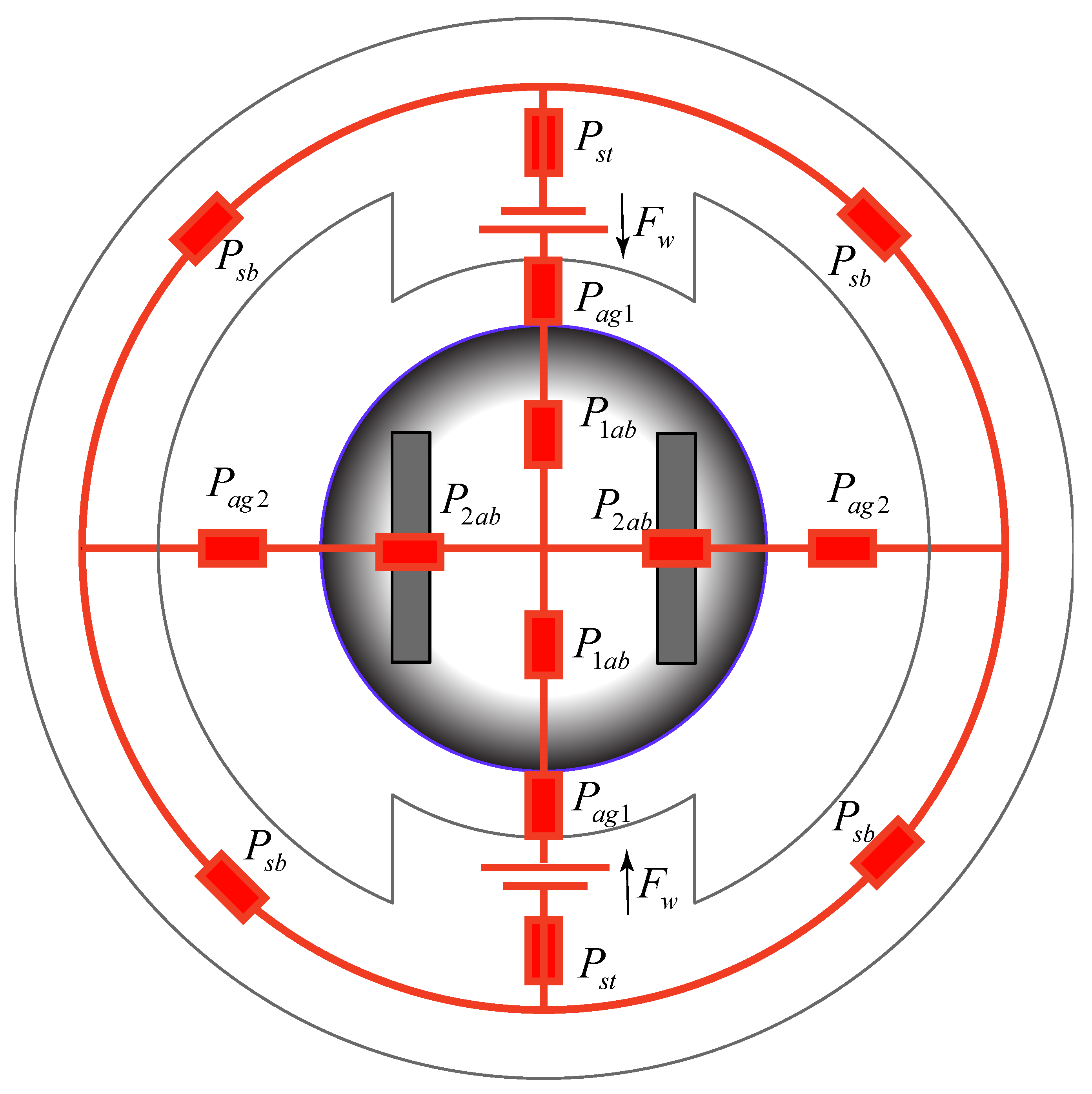
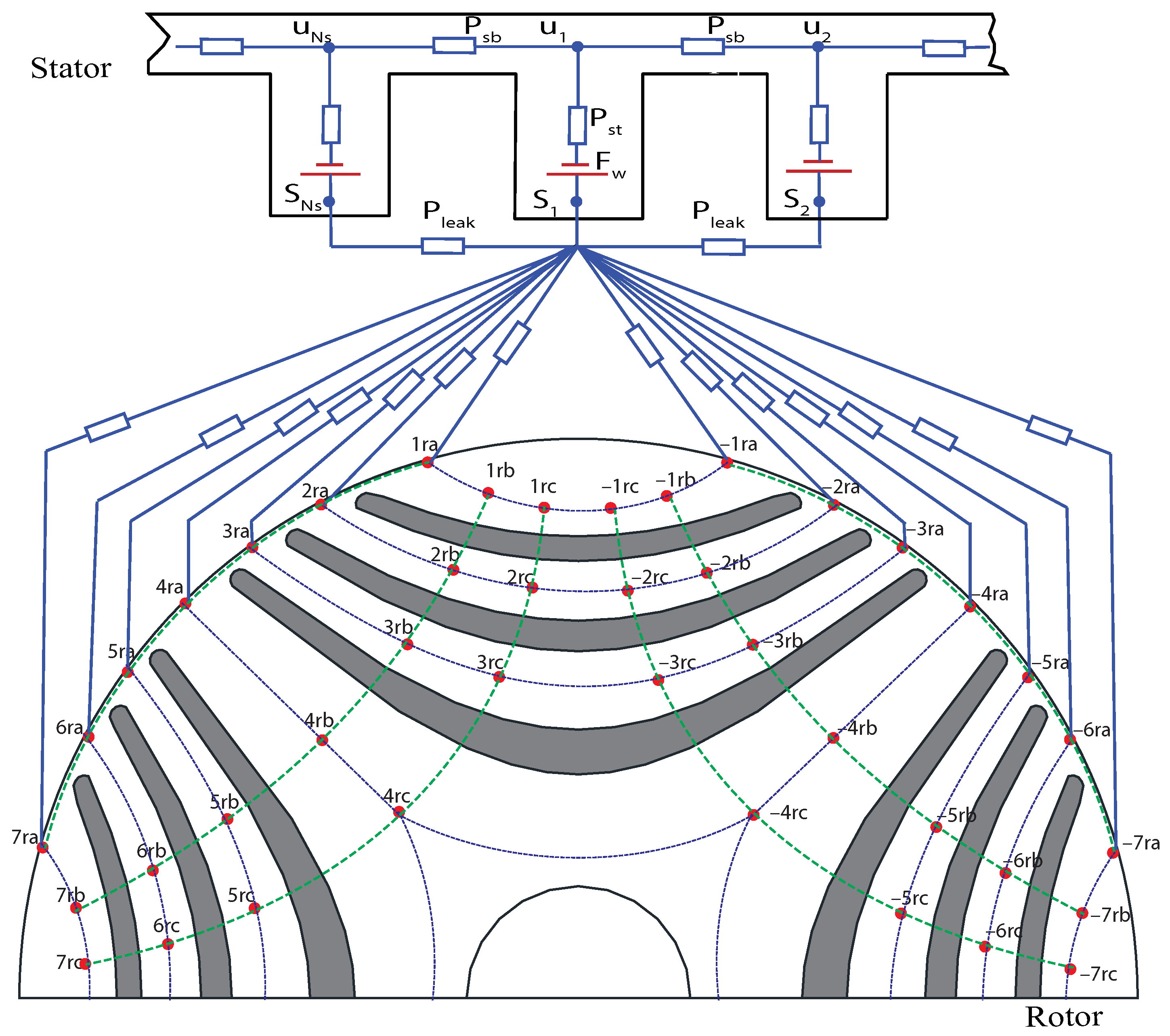
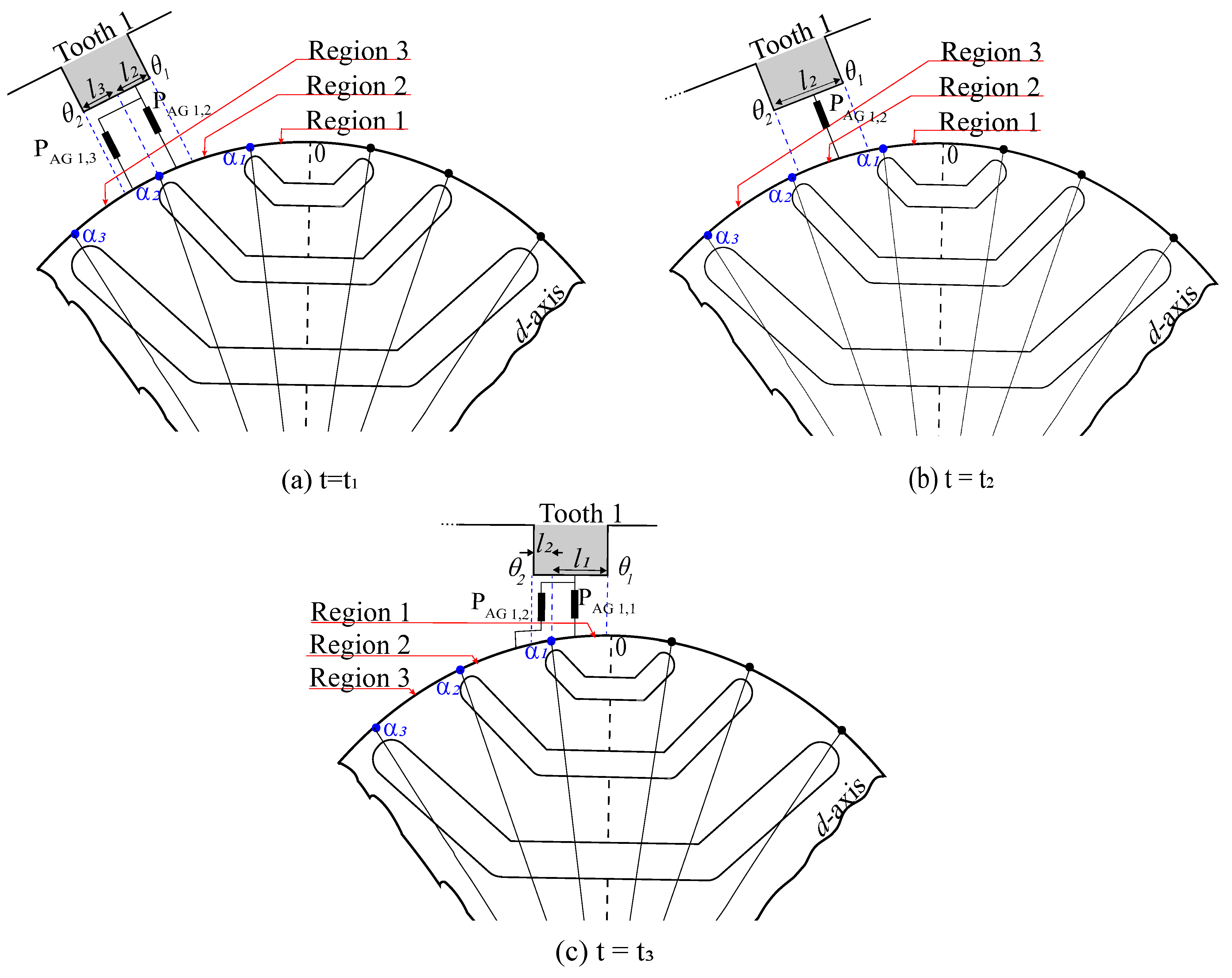
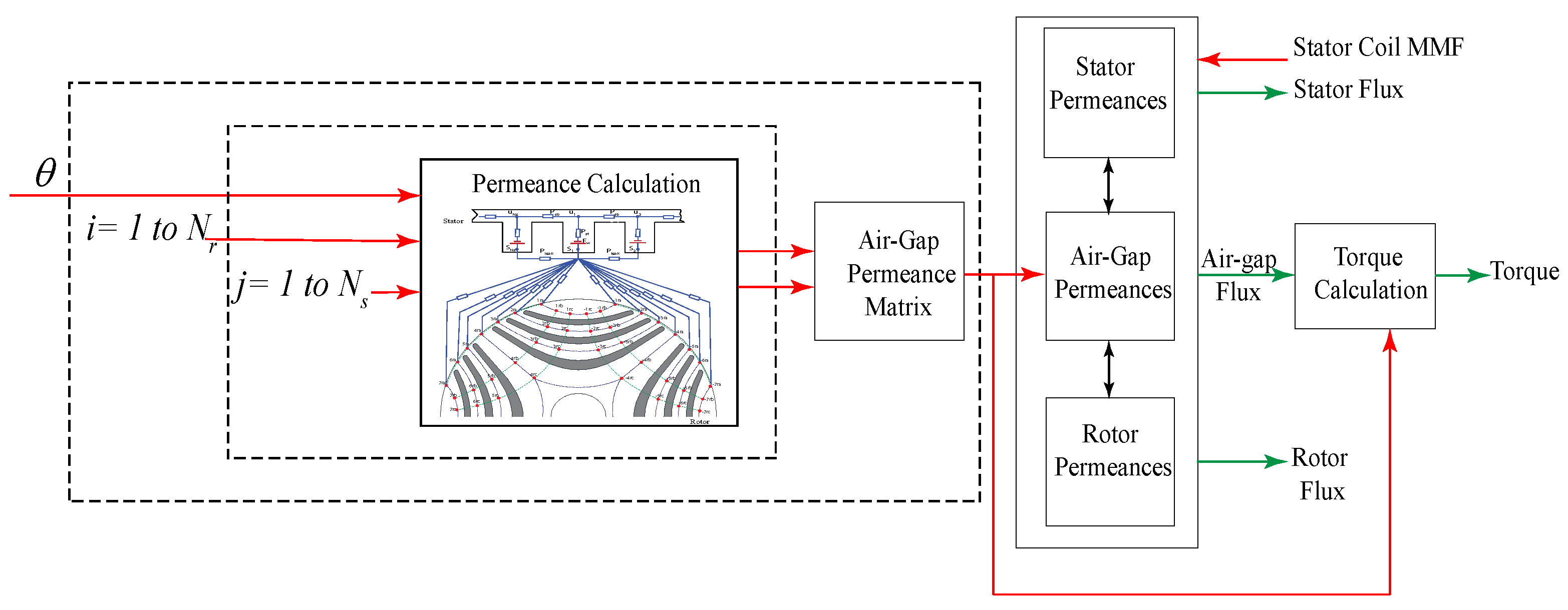

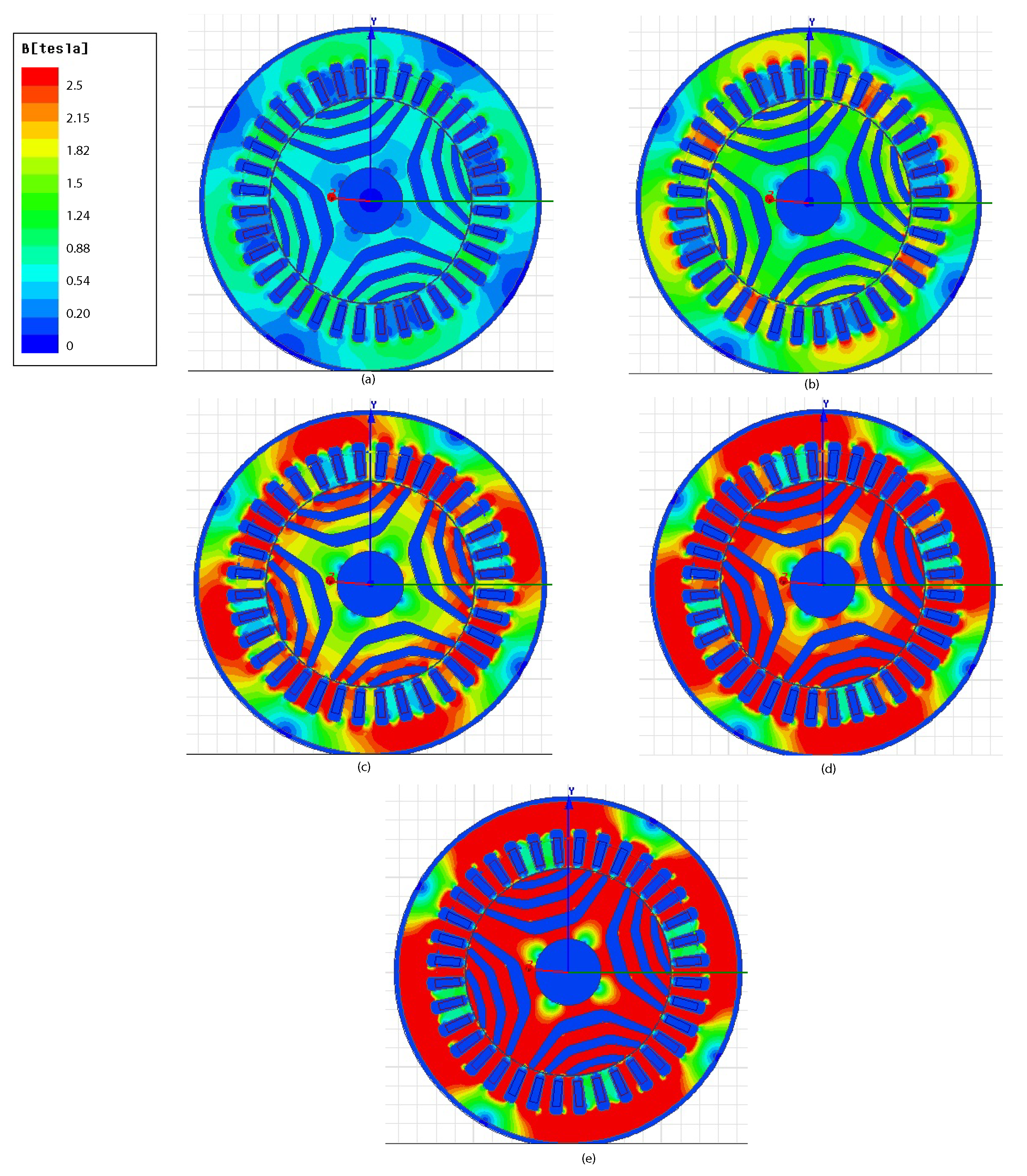
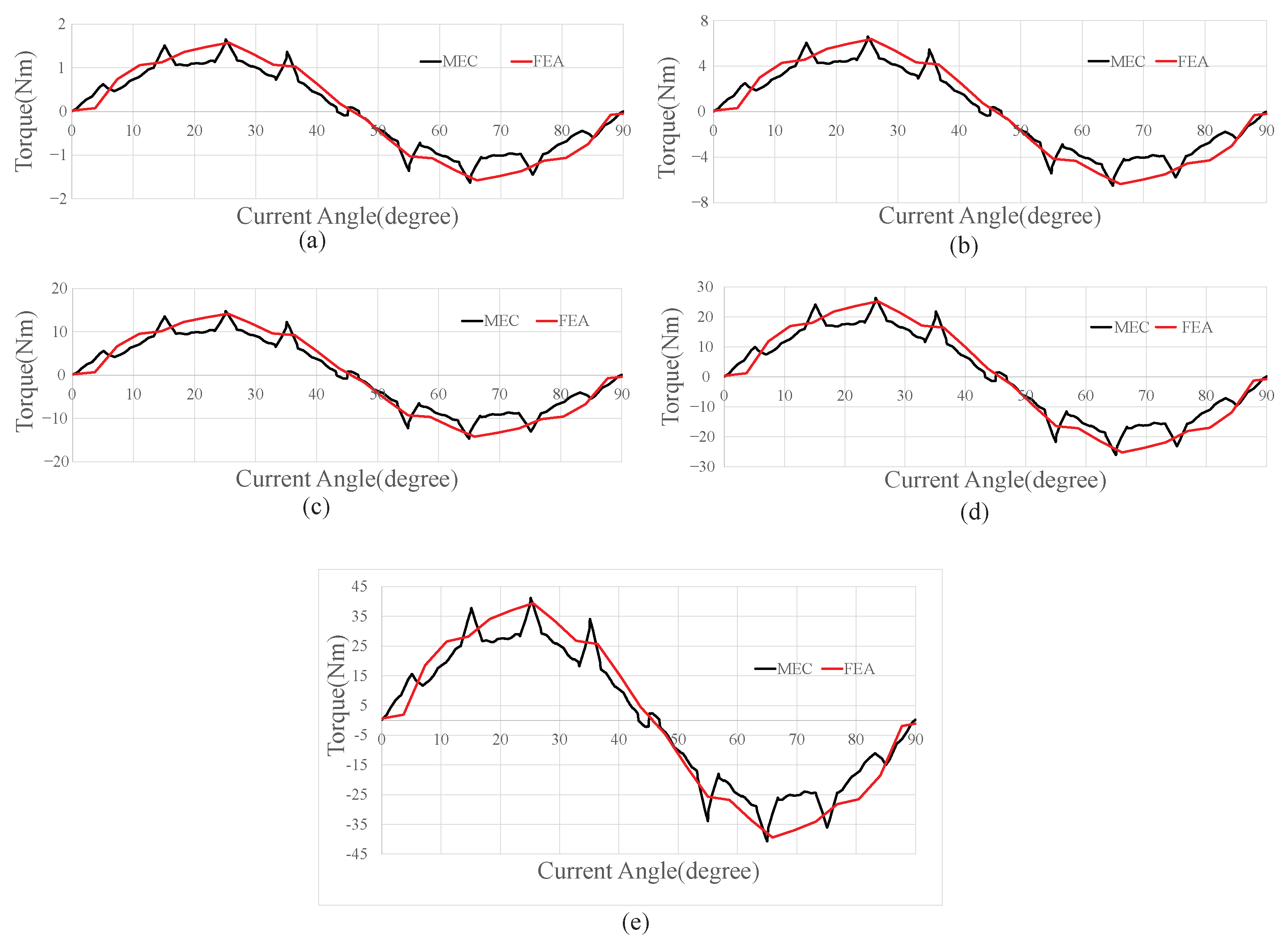
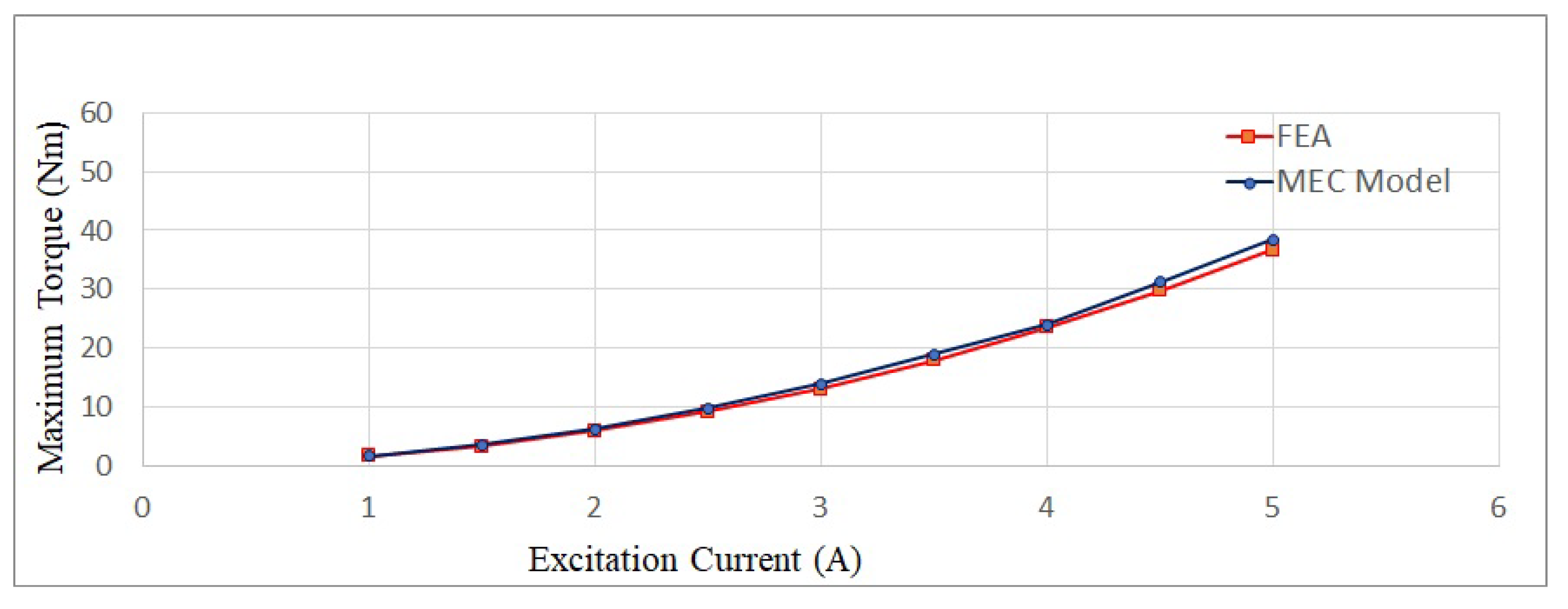
| Magnetic Potential vector at nodes ‘u’ | |
| Magnetic Potential vector at nodes ‘s’ | |
| Magneto motive force vector | |
| Magnetic Potential vector at nodes ‘ra’ | |
| Magnetic Potential vector at nodes ‘rb’ | |
| Magnetic Potential vector at nodes ‘rc’ | |
| Stator tooth permeance | |
| Stator back iron permeance | |
| Stator outer leakage permeance | |
| MEC | Magnetic Equivalent Circuit |
| Parameter | Value |
|---|---|
| Flux-barrier/pole | 3 |
| Rotor shaft diameter | 35 mm |
| Air-gap length | 0.3 mm |
| Axial length | 140 mm |
| Rated Current Density | 10 A/m |
| Number of turns | 100 |
| Number of phases | 3 |
| Rated frequency | 200 Hz |
| Number of stator slots/poles | 36/4 |
| Stator outer/inner diameter | 180/110 mm |
| Rotor outer diameter | 109.4 mm |
| Material type | iron (ideal) |
| Material relative permeability | 4000 |
| = 7.2° | = 18° | = 25° | ||||
|---|---|---|---|---|---|---|
| FEA | MEC | FEA | MEC | FEA | MEC | |
| A | 0.421 | 0.448 | 0.457 | 0.406 | 0.211 | 0.37 |
| B | 0.383 | 0.373 | 0.4 | 0.378 | 0.58 | 0.42 |
| C | 0.774 | 0.80 | 0.833 | 0.832 | 0.791 | 0.81 |
| D | 0.56 | 0.496 | 0.59 | 0.51 | 0.65 | 0.51 |
Publisher’s Note: MDPI stays neutral with regard to jurisdictional claims in published maps and institutional affiliations. |
© 2022 by the authors. Licensee MDPI, Basel, Switzerland. This article is an open access article distributed under the terms and conditions of the Creative Commons Attribution (CC BY) license (https://creativecommons.org/licenses/by/4.0/).
Share and Cite
Jayarajan, R.; Fernando, N.; Mahmoudi, A.; Ullah, N. Magnetic Equivalent Circuit Modelling of Synchronous Reluctance Motors. Energies 2022, 15, 4422. https://doi.org/10.3390/en15124422
Jayarajan R, Fernando N, Mahmoudi A, Ullah N. Magnetic Equivalent Circuit Modelling of Synchronous Reluctance Motors. Energies. 2022; 15(12):4422. https://doi.org/10.3390/en15124422
Chicago/Turabian StyleJayarajan, Rekha, Nuwantha Fernando, Amin Mahmoudi, and Nutkani Ullah. 2022. "Magnetic Equivalent Circuit Modelling of Synchronous Reluctance Motors" Energies 15, no. 12: 4422. https://doi.org/10.3390/en15124422
APA StyleJayarajan, R., Fernando, N., Mahmoudi, A., & Ullah, N. (2022). Magnetic Equivalent Circuit Modelling of Synchronous Reluctance Motors. Energies, 15(12), 4422. https://doi.org/10.3390/en15124422







